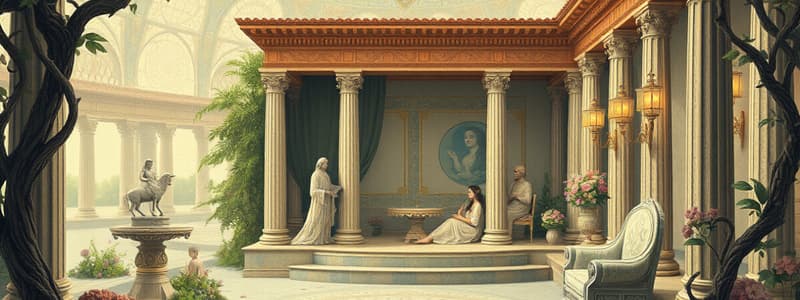Podcast
Questions and Answers
What is referred to by the term 'Etruscans'?
What is referred to by the term 'Etruscans'?
- A variety of Greek sculptures
- A type of ancient Roman art
- A civilization from 800 BCE to 500 BCE (correct)
- A style of architecture
What material was predominantly used for above ground Etruscan art?
What material was predominantly used for above ground Etruscan art?
Terracotta
What notable difference does Apulu have compared to the New York Kourous?
What notable difference does Apulu have compared to the New York Kourous?
Clothing and animated posture
What is depicted on the Sarcophagus with the reclining couple from Cerveteri, Italy?
What is depicted on the Sarcophagus with the reclining couple from Cerveteri, Italy?
What does the Banditaccia Necropolis in Cerveteri contain?
What does the Banditaccia Necropolis in Cerveteri contain?
The Tuscan columns on Etruscan temples differ by having a ______
The Tuscan columns on Etruscan temples differ by having a ______
Which of the following was a major contribution of Etruscans to Roman culture?
Which of the following was a major contribution of Etruscans to Roman culture?
What is the time span of Roman art periods?
What is the time span of Roman art periods?
In Roman culture, the ______ was the term for the male head of a family.
In Roman culture, the ______ was the term for the male head of a family.
The High Imperial period of Roman art was characterized by a rejection of Greco-Roman ideals.
The High Imperial period of Roman art was characterized by a rejection of Greco-Roman ideals.
What is the significance of the Arch of Titus?
What is the significance of the Arch of Titus?
What does the term 'veristic' refer to in Roman art?
What does the term 'veristic' refer to in Roman art?
What does the Ara Pacis Augustae celebrate?
What does the Ara Pacis Augustae celebrate?
What was the function of the impuvium in Roman homes?
What was the function of the impuvium in Roman homes?
Who was Augustus in relation to Julius Caesar?
Who was Augustus in relation to Julius Caesar?
What is the purpose of foreshortening in art?
What is the purpose of foreshortening in art?
Flashcards are hidden until you start studying
Study Notes
Etruscans and Their Influence
- Etruscan civilization flourished between 800 BCE and 500 BCE, influenced by Greek culture, particularly in language and art.
- Notable for a decentralized structure of city-states with a unified cultural identity and significant public roles for women.
- Focused on the afterlife contrasted with Roman priorities.
Etruscan Art and Architecture
- Apulu (500 BCE) is a terracotta statue from a temple roof, depicting a vibrant, animated figure distinct from Greek styles with lively expressions and dynamic poses.
- Sarcophagi from Cerveteri (520 BCE) feature a reclining couple, highlighting the centrality of women and unique cultural practices such as banqueting, not seen in Greek customs.
- Banditaccia Necropolis (7th-2nd BCE) serves as a large burial site, imitating the living environment with elaborate tomb designs and rock-cut furniture.
Etruscan Temple Model
- Etruscan temples utilized Tuscan columns, featured a single entrance, and were designed for frontal viewing, diverging from Greek architectural styles.
Innovations in Roman Art
- Development of the arch was pioneered by Etruscans, greatly influencing Roman architecture.
- Artistic evolution showcased during different Roman periods: Monarchy, Early Empire, High Empire, and Late Empire, with contrasting styles and cultural shifts.
Roman Portraiture
- Veristic portraits from 509-27 BCE depicted aging faces as symbols of experience and devotion to the state, emphasizing realism.
- Augustus (20 BCE) represented idealized divinity and youth, symbolizing peace and power through military imagery on his breastplate.
The Pax Romana
- Established under Emperor Augustus, marked a period of relative peace and prosperity within the empire, fostering artistic revival influenced by Greek classics.
Monumental Works
- Ara Pacis Augustae (13-9 BCE) promoted Roman peace and prosperity, featuring motifs of the imperial family and agricultural abundance.
- Column of Trajan (113-117 CE) narratively detailed military campaigns, showcasing Roman triumph and propaganda.
Decline and Transformation
- The Late Empire (193-337 CE) faced internal strife, including military turmoil and economic troubles, leading to a decline in artistic realism and an increase in symbolism.
- The Tetrarchs (300 CE) exemplified the shift towards block-like stylization and uniformity in representation.
Diverse Artistic Styles
- Roman wall painting evolved through four distinct styles, ranging from illusionistic techniques to ornate designs that emphasized decorative elements in domestic spaces.
- Foreshortening techniques were used to create depth and perspective in artworks, enhancing the realism of figures.
Domestic Life in Art
- Portraits of married couples depicted daily life and familial values, emphasizing realism and the importance of education in society.
Architectural Advances
- Roman buildings featured designs with open spaces, decorative marble mimicking, and structured atriums that enhanced light and community life.
- The influence of Greek architecture persisted throughout, adapting themes and styles to suit Roman societal needs.
Symbolism and Representation
- Late Empire art frequently reflected the turmoil through simplified forms lacking earlier individuality, focusing instead on conveying broader themes of power and authority.
Studying That Suits You
Use AI to generate personalized quizzes and flashcards to suit your learning preferences.




